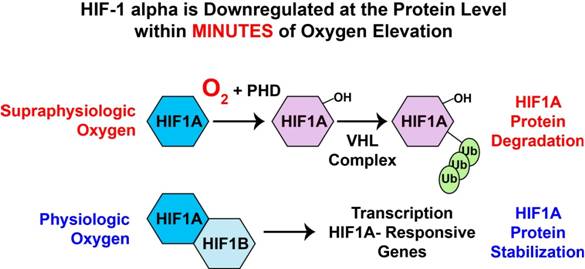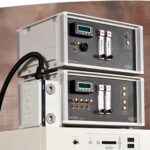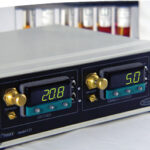The Biology of HIF Proteins Impacts the Outcome of Your Experiments in Physiologic Oxygen:
Considerations for protocol design
We recently posted an article “What Oxygen Level Should I Use for My Cells In Vitro?” in response to questions that we have fielded from customers getting started in cytocentric research. To expand on that topic, we are posting here a few more resources for information on the mechanism of how changes in oxygen levels impact cells in culture.
Cellular responses to oxygen are mediated in part by hypoxia-induced factors (HIF-1 and -2 protein families). These transcription factors control a wide variety of cell functions, and are among the most rapidly regulated proteins known to date. If you culture your cells at physiologic oxygen levels and expose them to supraphysiologic oxygen during room air handling, it can affect your results.

A Simplified Model of HIF-1a Regulation by Oxygen. The regulation of hypoxia inducible factors occurs at multiple levels over time, but the regulation at the protein level by prolylhydroxylases (PHD) in the presence of elevated oxygen occurs on a time scale of minutes. PHD family enzymes hydroxylate proline residues on HIF1a allowing binding by Van Hippel Landau (VHL) and other proteins. HIF1a is then rapidly poly-ubiquitinated and targeted for degradation.
See this publication for data on the extraordinarily fast responses of HIF levels to pericellular oxygen changes:
Jewell, U. R., Kvietikova, I., Scheid, A., Bauer, C., Wenger, R. H., & Gassmann, M. (2001). Induction of HIF-1alpha in response to hypoxia is instantaneous. FASEB J, 15(7), 1312-1314.
Regulation of HIF proteins can have dramatic effects on your cells in culture
HIF is a transcription factor with a broad range of target genes. Cellular functions downstream of the HIF include not only fundamental metabolic machinery, but also many functions related to cell migration, proliferation and differentiation. With a critical role in normal function of chondrocytes and other low-oxygen dwelling cell types, HIF also is key to the pathophysiologic response of many tissues to ischemia/reperfusion injury.
Gregg Semenza’s group first described HIF proteins as oxygen sensors in the 1990s. See a recent review of his for more on the role of HIF proteins:
Semenza, G. L. (2014). Oxygen sensing, hypoxia-inducible factors, and disease pathophysiology. Annu Rev Pathol, 9, 47-71. doi: 10.1146/annurev-pathol-012513-104720
Even brief exposure to room air during cell handling affects cells
Because HIF is regulated so quickly, at the protein level, it is extremely important to reduce the exposure of cells to even briefly elevated oxygen levels. Cell handling in room air was recently shown to have a dramatically negative effect on the cellular yields of hematopoietic stem cells from both umbilical cord blood and bone marrow:
Mantel, C. R., O’Leary, H. A., Chitteti, B. R., Huang, X., Cooper, S., Hangoc, G., . . . Broxmeyer, H. E. (2015). Enhancing Hematopoietic Stem Cell Transplantation Efficacy by Mitigating Oxygen Shock. Cell, 161(7), 1553-1565. doi: 10.1016/j.cell.2015.04.054
For a great summary of recent findings on regulation of hypoxia inducible factors, see this recent Cell SnapShot:
Lee, K. E., & Simon, M. C. (2015). SnapShot: Hypoxia-Inducible Factors. Cell, 163(5), 1288-1288 e1281. doi: 10.1016/j.cell.2015.11.011
HIF biology affects your protocols in Cytocentric research
Because hypoxia inducible factors are regulated so rapidly and cells are affected by even brief exposures to room air oxygen, for the best results:
We strongly recommend planning your experiments to control the cell microenvironment during cell handling as well as incubation.
Cytocentric equipment for full-time oxygen control is designed to accommodate the cells’ need for full-time physiologic simulation.
Recent Articles

Cytocentric Visionaries Hal Broxmeyer
Cytocentric Visionaries: Hal Broxmeyer November 27, 1944 ~ December 8, 2021 Hal Broxmeyer telling Randy Yerden about his latest findings in June 2016. The average height of the Cytocentric researcher has been reduced, now that we have lost a giant. Hal Broxmeyer died...

Cytocentric Visionaries: Dr. David Gozal, MD – Part Two
Cytocentric Visionaries: Dr. David Gozal, MD Part 2: COVID-19 Research, Prone Positioning, and Chronoadequacy Alicia Henn, PhD MBA, Chief Scientific Officer, BioSpherix David Gozal, MD, MBA, PhD (Hon) is the Marie M. and Harry L. Smith Endowed Chair and Chairperson of...

Cytocentric Visionaries: Dr. David Gozal, MD – Part One
Cytocentric Visionaries: Dr. David Gozal, MD Part 1: COVID-19, ACE2, and the Circadian Clock Alicia Henn, PhD MBA, Chief Scientific Officer, BioSpherix David Gozal, MD, MBA, PhD (Hon) is the Marie M. and Harry L. Smith Endowed Chair and Chairperson of the Department...
About The Author
Alicia D Henn, PhD, MBA
Chief Scientific Officer of BioSpherix, Ltd
Alicia Henn has been the Chief Scientific Officer of BioSpherix, Ltd since 2013. Previously, she was a researcher at the Center for Biodefense Immune Modeling in Rochester, NY. Alicia obtained her PhD in molecular pharmacology and cancer therapeutics from Roswell Park Cancer Institute in Buffalo, NY and her MBA from the Simon School at University of Rochester in Rochester, NY.
If you would like to be featured in our Cytocentric Visionary Series, contact us. We would love to hear about your work.





































